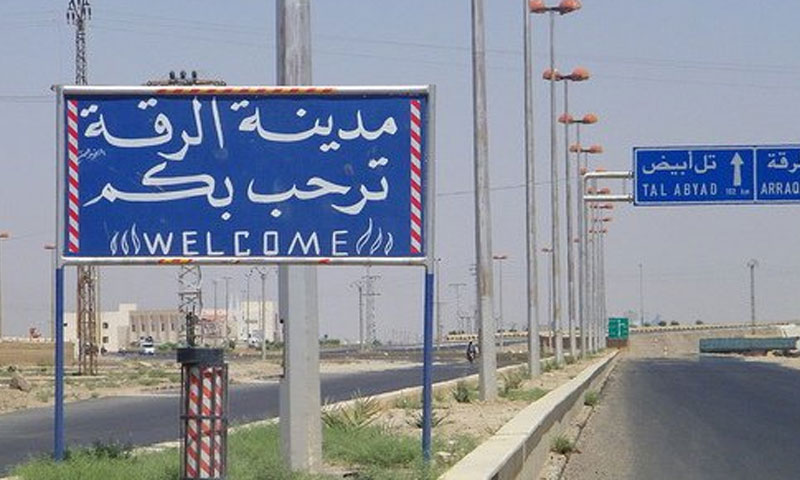



The ” People’s Municipality” affiliated to the “al-Raqqa Civil Council” announced on 24 June a new regulatory plan for the expansion of the real estate zone (A) from the “Silos” Roundabout in the east to the “Hazimah” Roundabout in the west, which will be implemented during the current year.
The city’s municipality allowed those affected by the plan to submit their legal objections to the “Planning and Urban Regulation Department” within 30 days from the issuance date.
In an interview with Enab Baladi, the joint head of the “People’s Municipality” in al-Raqqa, engineer Ahmed Ibrahim, pointed out that what had been issued was the blueprint for the organizational plan, announced in both the “People’s Council of Syria” and the “Council of the Municipality,” and the “al-Raqqa Civil Council.”
Ibrahim added that the municipality started to receive the objections from the residents of the area included in the urban planning scheme, who will lose part of their property or all of it.
Ibrahim indicated that according to statistics on the expected damages of the plan, only 5 percent of the area’s population might be affected due to the execution of the proposed outline.
He clarified that the affected people would be compensated within a mechanism to be studied by the “Judicial Council,” the “Municipal Council,” as well as the “Civil Council.”
The compensation guarantees the allocation of other plots for those who will lose their entire property, or compensation for the built-up concrete housing units, according to fair market prices.
According to Ibrahim, the project includes the urban planning and organization of the area between the “al-Sunbulah” Roundabout and the “Hazimah” Roundabout.
He added that this area is an uncharted territory built to the northern part of al-Rqqaa. Ibrahim said that the northern region of the city was targeted by the expansion plan for having a medium population density.
According to Ibrahim, the city’s regulatory plan was previously expanded about two kilometers east and west, and there was no possibility of expanding to the south due to the existence of the “Euphrates River.”
Ibrahim said the city’s organizational plan had to be expanded to solve the residents’ problem caused by the limitation of this plan and the increasing population density, which led to the rise of real estate prices.
Therefore, the municipality decided to expand northward, in excluded lands that are unfit for cultivation for future food security, and to prevent urban sprawl at the expense of farmland, Ibrahim added.
Ibrahim explained to Enab Baladi that the area the municipality intends to regulate is an area of slums, where construction work is prohibited since the Syrian regime was controlling it
This area has buildings and is not empty or unpopulated lands, Ibrahim said.
He continued saying that the regulation of the area will allow the construction of floor buildings in a formal, planned, and organized way, which will prevent the establishment of unauthorized buildings that are difficult to remove after being inhabited by people.
Ibrahim also pointed out that the regulatory project will provide water, electricity, and sewage system, in addition to all the services the area needs.
According to Ibrahim, a decision was obtained from the ” Higher Regional Committee” for the city’s vertical expansion.
This decision allows the maintaining of the same regulatory plan and the construction of an additional floor for new buildings and those that structural integrity reports allow the addition of a new floor to them.
Nevertheless, the vertical expansion plan did not serve the area enough; therefore, a horizontal expansion was necessary this year, to create sites appropriate for buildings with floors.
Concerning the dwellers of the new buildings and what was circulated that they will be housing the displaced people of Afrin and exclude the Arab residents of al-Raqqa, Ibrahim said that “the area includes inhabited buildings, which is confirmed by aerial photographs of the area.”
Ibrahim said, “it is unreasonable for the municipality to expel someone from his home to give the house to someone else, which nobody would accept, and would result in protests and demonstrations by the people.”
Ibrahim considered the news that the urban development project’s goal was to provide shelter to the Kurdish displaced people from Afrin, as baseless “media fabrications.”
He confirmed that the Kurdish-led Autonomous Administration of North and East Syria (NES) is against Afrin people’s resettling in their areas of control because it believes that they must return to their original homes.
The NES provides the displaced people of Afrin with services such as camps, food baskets, and financial aid; however, it emphasizes that they must not forget their rights to their original lands, Ibrahim said.
Meanwhile, the city of al-Raqqa came under the control of the NES in 2016 after the Syrian Democratic Forces (SDF) removed the “Islamic State” organization (IS) through a military campaign backed by the US-led International Coalition Forces (ICF).
For its part, Turkey supported a military operation against the Kurdish “People’s Protection Units” in Afrin and controlled it in March 2018.
The Afrin area witnessed displacement waves of original residents for several reasons, mainly the security conditions.
if you think the article contain wrong information or you have additional details Send Correction